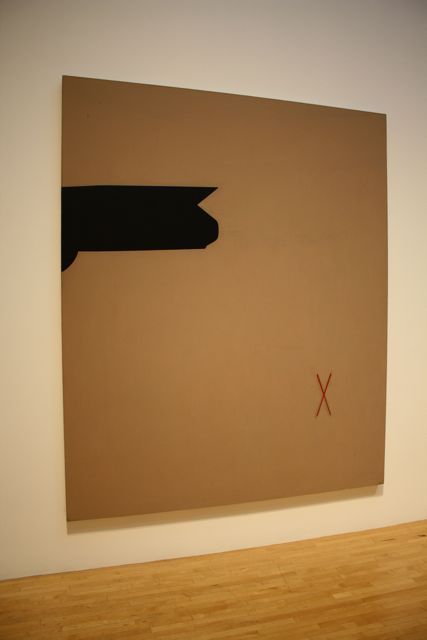Hannah Levis, Heart. Stain; University of Nottingham.
Hannah Levis, Heart. Stain; University of Nottingham.
This was actually a suggestion by a research assistant that is working on a neuropsychological study with me this summer. It comes from an exhibition in which students and scientists around Europe submitted pictures of their work. The stains come from their own lab experiments/research.
This particular stain is the purkinje cells from the cerrebellum (a region of the brain that controls motor function) that have been stained with calbindin. From looking at the stain, you would never know that (unless you are my fellow research assistant that quickly pointed out it was the cerrebellum). And it is so aptly named–that was the first thing I thought of–a heart.
But I thought this stain was appropriate because with this research this summer, I’ve looked at so many MRIs, whole brain MRIs, looking at white matter lesions and abnormalities. And I get really really sick of it. So to see this–you remember how intricate and beautiful the brain is. It is one part of your body that really has control of the rest of your body, in terms of senses, movement, memory, and emotions. And if cut in a certain way and stained in a certain way, it can produce something you would never expect. Like a heart.
No one ever expects science to be beautiful. From the outside, it seems like an objective, extremely methodical subject. But this proves that it doesn’t always have to be.
Caravaggio, The Entombment of Christ, 1602-1603. Oil on Canvas, 120 in. × 80 in.; Pinacoteca Vaticana, Vatican City.

Caravaggio, The Entombment of Christ, 1602-1603. Oil on Canvas, 120 in. × 80 in.; Pinacoteca Vaticana, Vatican City.
This weekend, someone told me they like the crazy artists. Caravaggio is one of them.
Jules Aaron, Untitled, 1947-1976. Photograph; The Boston Public Library.

Jules Aaron, Untitled, 1947-1976. Photograph; The Boston Public Library.
Isn’t this photograph beautiful? I don’t even know how to describe how much I love it.
About a month ago, I went to Boston and my friend showed me her favorite place–The Boston Public Library. I have always walked past it, never went in. But they had an exhibition on the third floor and she really wanted to see it.
Jules Aaron is actually a famous physicist, known for his work on radio-waves. But he is also an accomplished photographer. Although raised in New York, he was very fond of Boston (went to school at Boston University) and spent most of his life there. He most especially enjoyed taking photographs of the ethnic diversity of the North End, West End, and the South End.
This photo encapsulates so many things I love–the 50’s, Boston, old Chevrolets, the fashion. It so smoothly captures the attitude of the men, as they all look in one direction, even the man in the back. But the incongruence of the man in the middle, the only one with his shirt unbuttoned and the only one with a print on his shirt and the only one not looking in the same direction. I wish I could go back in time and see what they are looking at, drive in that Chevrolet with them, and learn who they are. And isn’t a photograph supposed to make you want to do that?
Prada, Dress, Fall/Winter 2000. Silk and Plastic, 46 1/2 in. length; The Met, New York.

Prada, Dress, Fall/Winter 2000. Silk and Plastic, 46 1/2 in. length; The Met, New York.
In the spirt of New York Fashion Week, which started on Thursday, February 11th, I decided to write a post about this Prada dress.
Prada is an Italian fashion label, originally found by Mario Prada in 1913. But it was his granddaughter, Miuccia Prada (where the brand Miu Miu comes from), in 1978, took over. She started with designing backpacks and totes, but it was a simple, nylong bag that started a following that launched the Prada into the fashion world. Prada now specializes in mens’ and womens’ “luxury goods.”
I think my first “encounter” with Prada was when I was really really young. It had something to do with their black patent leather wallets that have the upside-down triangular metal label–that oh-so-famous staple of the brand that other fashion designers now employ such as Marc Jacobs.
Fashion is art so it is no surprise that the “trends” in fashion cycle. This was made ten years ago and now, sequins are coming back in style with a vengeance (But are they really going to stay? They may have already gone out of style. But that discussion is for another blog..)
But I really love this dress and it’s deep v-neck that manages to stay classy by not having a extremely high hem-line. The sequins not too shimmery and not too small. What is so great about fashion is that it is designed for the woman’s body–a black belt around the waist to accentuate it. A woman would feel absolutely beautiful wearing this Prada dress.
For Fall 2010 Ready-to-Wear NY fashion week, Rag & Bone has so far been my favorite.


Their first womens’ show, David Neville and Marcus Wainwright make plaids and thick tweeds so feminine. With this, I never want to leave the menswear aesthetic.
J
Vilhelm Hammershoi, Interior with a Girl at the Clavier, 1901. Oil on canvas.

Vilhelm Hammershoi, Interior with a Girl at the Clavier, 1901. Oil on canvas.
Hammershoi is a Danish painter known for his quiet and calm paintings. He is most famous for his lack of bright colors, and instead, opts for muted ones. His work is often described as melancholy, as the figures are always turned away from the viewer.
I wouldn’t necessarily call his work melancholy. I love the muted tones, especially the blue in the wall with the white patches of paint scattered across it. It feels as though I’m not looking right into a scene, a cloud is covering my vision. It gives it such a soft and ethereal touch.
However, in this painting, Interior with a Girl at the Clavier, I feel as though I am invading the girl’s privacy. I stand behind a table to keep my distance from her, in case she hears me. Maybe I feel this way because that’s how I view my piano–it’s my space to practice, to make mistakes, to read my sheet music. That’s probably why I enjoy the Steinart practice rooms at Brown, so much. Even though they are these strange boxes you step into, you can lock the door, they are soundproof. You can practice without any distractions. And that’s what I think Hammershoi captured so well.
J
Johannes Vermeer, The Milkmaid, 1657. Oil on canvas, 17 7/8 in. x 16 1/8 in., 45.5 cm x 41 cm; Rijksmuseum, Amsterdam.

Johannes Vermeer, The Milkmaid, 1657. Oil on canvas, 17 7/8 in. x 16 1/8 in., 45.5 cm x 41 cm; Rijksmuseum, Amsterdam.
Over Thanksgiving break, I went to New York City and of course, when you are in New York City, you have to make a stop at the Metropolitan Museum of Art. This was only my second time visiting–and this time, I had a lot more time. What’s so great is that the Met is so busy, so full of life, with crowds of people walking in and out all the time. With more time, I realized how large the museum was and how much art it held–it was overwhelming (in a good way).
It is impossible to go to the Met for one day and even try to appreciate, or even simply look, at every piece of artwork. There were so many Courbet, Degas, Manet, Miro paintings that I had learned about, had never seen, and I wanted to give them each the time they deserved. And then, you also want to go to the special exhibitions. If I lived in New York, I would go to the Met every weekend to just stay in one wing or even just a few rooms to understand each piece of artwork.
The day before I was to go to the Met, I didn’t even know that they were holding a exhibition on Vermeer until my friend told me. It could not have been better timing–because it was the second to last day of the exhibition. I could not contain my excitement. To see a painting, in person, up close, by your favorite painter is not something you can describe.
Being so close to the painting made me nervous. I could see every single crack and it felt like the painting was just going to collapse right in front of me. But being so close also reminded me why I love Vermeer so much. His use of color is so vibrant. The blue in the milkmaid’s dress is no blue that you could find in a box of crayons, it is so bright and contrasts so well with the red that it immediately catches your eye. And his use of light is so delicate–slowly shading the back, white wall and subtleties of the light from the window hitting the milkmaid’s hand.
My favorite part of the painting is the bread. You could never tell from looking at a reprint online, but Vermeer paints the bread with single dots that blend together to form the texture of the bread. It is such a meticulous and delicate technique–but it makes the bread that much more real, more tangible.
The exhibition also had only a few of his other paintings. I loved seeing the cartography in the background of his paintings and it must have taken him so many months to just paint the maps, as they are so detailed. It was also just so great to see so many people in the small room, so eager to see all of Vermeer’s paintings. It was nice to be amongst people standing for more than five minutes to admire Vermeer’s beautiful work.
Other paintings:

Ilia Efimovich Repin’s Vsevolod Mikhailovich Garshin
What a great capture of a mentally struggling writer.

Norman Rockwell’s Town Meeting
It reminds me of my childhood, when I would look through my cousin’s oversized Norman Rockwell book. Doesn’t this painting just inspire you?
J
Rene Magritte, The Voice of Silence, 1928. Oil on canvas, 57 cm x 73 cm; Worcester Art Museum, Worcester, MA.

Rene Magritte, The Voice of Silence, 1928. Oil on canvas, 57 cm x 73 cm; Worcester Art Museum, Worcester, MA.
Usually, I really dislike surrealism. There is something about it that I find about it to be disingenuous, as though this glossy film is placed on top. It might be because surrealism did stem from Dadaism, which was an inherent rejection of the ideas of “art,” while still creating art. In that sense, I found surrealism to be somewhat mocking and not as inviting as other styles of art.
However, this past Friday, for my Roman Art: Hadrian to the Late Antiquity class, we took a small field trip to the Worcester Art Museum. I was expecting it to be a small, little town museum, with around three rooms, but it surprised me. It was pretty large and had a great collection of work. We went to mainly look at their floor mosaics that were on display in the main room. But after an hour or so with the curator, we had about an hour of free time.
In the very last room, I found this Magritte painting, The Voice of Silence. It’s the Worcester Art Museum’s first surrealist painting. What immediately caught my eye was the immense amount of black on the left side–and looking closely at it, it was completely black. Not just extremely dark grey, but completely black. And just looking into the black space made me, almost feel afraid–as though something was going to jump out.
I just feel this ominous sense from the painting, as though there is someone in the dark room, but we, as the viewer, just don’t know. And even though there aren’t any people on the right side of the painting, I get this sense of “never being alone”–people are always around and listening. You don’t know who is in the next room. And it is accentuated with the stark contrast of color, the symmetry of the space between the two sides of the painting, and the placing of a thick wall right in the middle.
J
The Guild of Food Writers Logo

Isn’t this logo just absolutely charming? It’s the logo for the Guild of Food Writers, which is an association for food writers in the UK. After reading a little about the group, I’m really amused that one of its activities is “campaigns for improvements in the quality of food.” I wholly support that.
What I love about logos are that they are so clever. They are so simple, but always manage to blend ideas together–an obvious one and then a not-so-obvious one. In this case, the obvious one is that it is the tip of a calligraphy pen, symbolizing the art of writing. But if you just look at the logo a little bit more, the negative space creates an image of a spoon.
Even though this logo seems like a black stamp of the end of a pen, it’s so witty in the way that it incorporates exactly what the Guild of Food Writers is all about.
J
Forever Young by Bob Dylan

Forever Young by Bob Dylan and illustrated by Paul Rogers
I saw this at Barnes and Noble the other day. It’s a children’s book based on Bob Dylan’s hit song, “Forever Young.”
1. Bob Dylan is amazing.
2. I love Paul Roger’s 60’s-esque style of artwork.
3. It is too adorable.
J








leave a comment